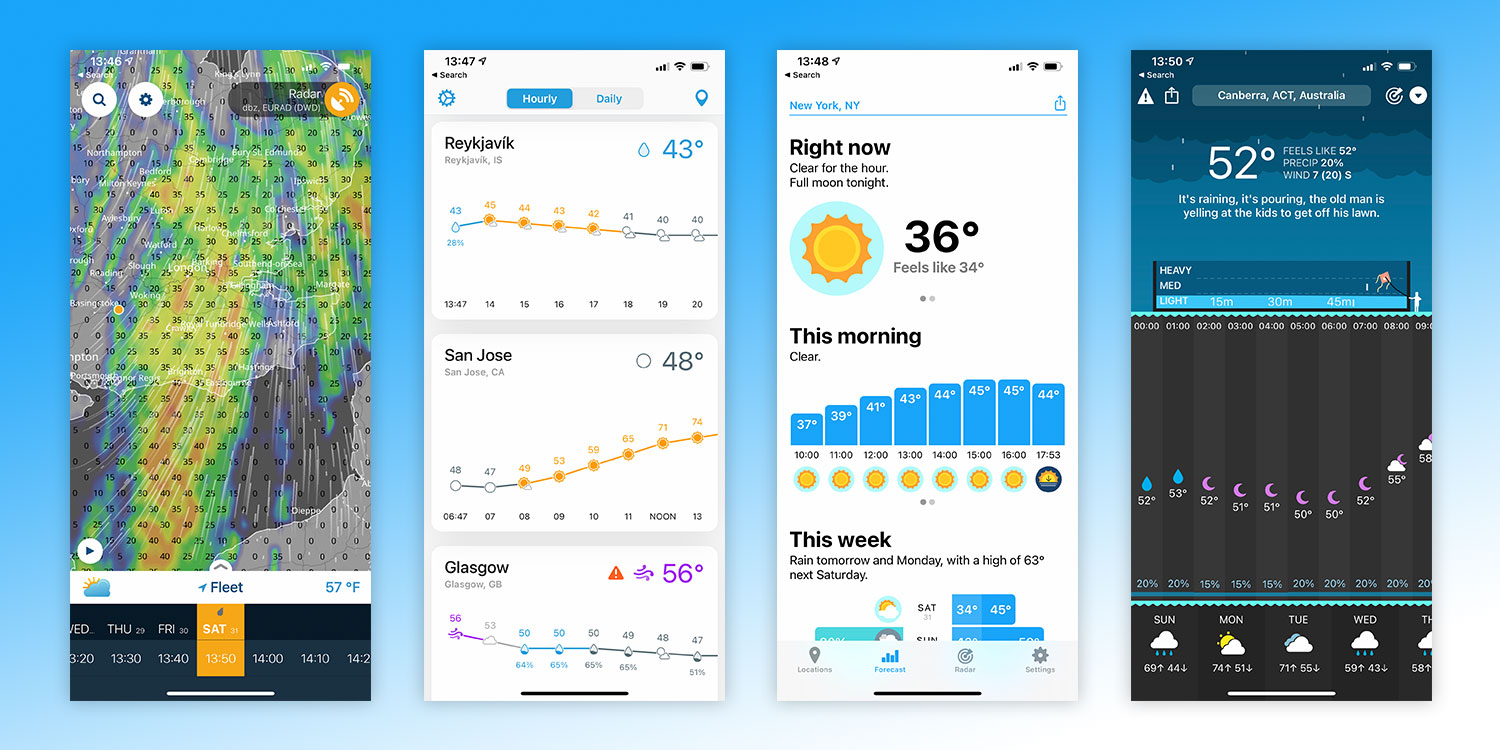The outlook’s sunny if you want a great-looking feature-packed weather app
Much-loved weather app Dark Sky is going dark. The snag is, we don’t know when. This round-up outlines why this is a bad thing (we’re fans) and your best bet for alternatives when new owner Apple pulls the plug.
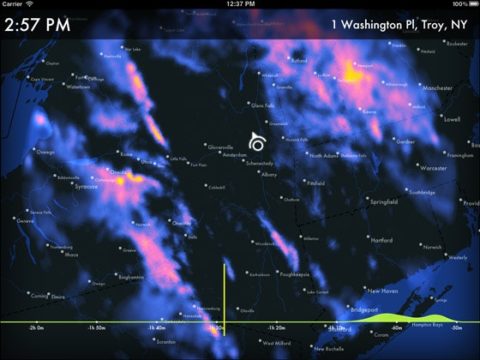
Back in 2012, after a Kickstarter campaign, the original Dark Sky pulled off the trick of being visually arresting, unique and genuinely useful. Unencumbered by the need to satisfy the feature set of more typical weather apps, it was intentionally limited to focus on the next hour.
In ignoring all but the imminent future, Dark Sky’s hyperlocal forecasts let you know if stepping outside would mean a soaking in half an hour; and its map view dazzled as neon clouds billowed across gray lines atop a jet-black background.
How Dark Sky evolved — only to be eaten
Over time, Dark Sky expanded its reach. It became more traditional in nature. The latest incarnation of the Dark Sky app ($4/£4) still features a map, now wrapped around a zoomable, thumbable globe; but the main view includes a stylish, minimalist forecast, with an embedded, static miniature map outlining nearby rainfall.
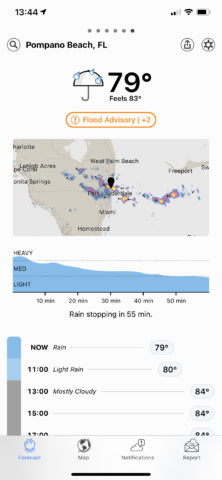
Simultaneously, Dark Sky got its hooks into the weather apps ecosystem through an API other apps could incorporate. Many now rely on Dark Sky data for their foundation, primarily due to that ‘next hour’ rainfall forecast. And then Apple came calling.
In April 2020, Apple bought Dark Sky. The Android app was shuttered, and although an online version remains, it too was planned to close this past summer. The API will function until the end of 2021. Frustratingly, Apple has to date done little with Dark Sky beyond integrating an imminent rainfall graph into its own Weather app — and even then only for US locations.
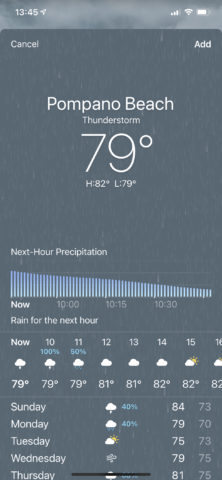
How to choose a weather app
When looking to replace Dark Sky, it’s worth being mindful of its shortcomings as well as its positives. One of the app’s creators said the team’s work was numerical and statistical rather than meteorological. The original system would, he suggested, “never be able to predict six hours in the future, let alone a day from now.” Although Dark Sky evolved, it never quite shook off a reputation for poor long-term accuracy.
Still, Dark Sky is far from alone in being a product of algorithms and models. We today see weather apps boast of accurate hyperlocal forecasting. These should be taken with a pinch of salt, because forecasts are often based on interpolation of weather center data rather than direct readings — hence why you’ll sometimes stare at an app claiming there’s blazing sunshine all around while a grey sky lurks overhead. (Similarly, treat long-term forecasts as informed guesses and your life will be a happier one.)
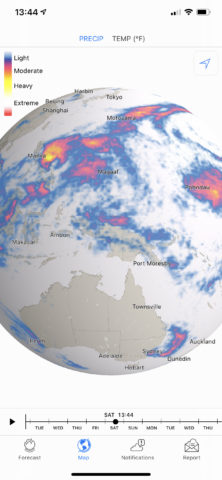
If you’re a dedicated Dark Sky user — or someone who likes the idea of a weather app designed around immediacy and great design — there are key things to consider when perusing the App Store. You need a weather app that’s usable, with great clarity, and ideally that enables you to switch sources if its primary one isn’t good for your current location (thereby potentially removing hyperlocal accuracy problems). Also, weather data is not free, and so don’t begrudge a weather app if it demands monthly IAP to keep the lights on!
4 great Dark Sky alternatives for iPhone
Which apps should you consider, then, to replace or augment Dark Sky? We reckon the outlook’s sunny for the following four…
Ventusky
$3/£3 • v13.0.1 • 72MB • By InMeteo, s.r.o.
It’s unfair to say Ventusky is all about the map, but this is the one app that in that area visually gives Dark Sky a run for its money.
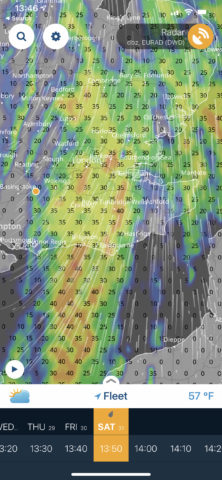
The animation here comes from wind lines that streak across the map, instantly helping you figure out where rain and snow is going to head. Map animation is far jerkier than in Dark Sky, but does come with the benefit of multiple alternate layers, including air pressure, air quality, and temperature.
Elsewhere, drag up a tab and you get busy but scannable conditions for the current hour, along with the next and previous few. Drag the tab up further, to fill the screen, and you’ll access a weekly outlook (with handy wiggly lines for maximum and minimum temperatures, which can be switched for wind/precipitation bar charts), along with extensive daylight information. Plenty of customization rounds out a solid Dark Sky alternative you can adjust to your needs.
Weather Line
Free or $4/£4 per month • v2.7 • 111.5MB • By Off Coast LLC
The key selling point of Weather Line is how it displays information. As the app’s name suggests, forecasts are presented as a line, denoting temperatures at each hour or day. Simple icons — blue rain drops; gray clouds; yellow or orange suns — make it a cinch to at a glance see what weather’s coming up.
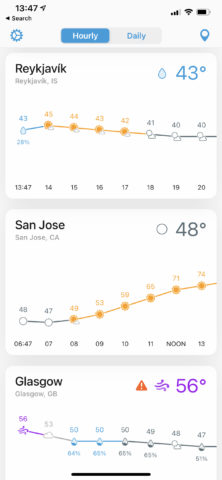
The app’s friendly nature extends to the finer details. In its settings, you can rename locations (for example, adding a friend or family member’s name), providing added context when browsing saved cards on the main display. Open a location and you can delve into rainfall predictions, an animated radar, and monthly averages that prove useful for planning trips.
The free version has limitations: hourly widget updates (versus every five minutes), no real-time precipitation graph, no looping radar, and integrated ads. But it’s a superb app for tracking multiple locations whether you choose to pay or not — and if you do, you get meaningfully useful upgrades.
Hello Weather
Free or $1/£1 per month • v3.7.9 • 39.3MB • By Electric Dream Machine Inc.
The tendency with modern visual design is toward minimalism. Hello Weather tries something different, its interface being vibrant and bold, bordering on cartoonish — but in a good way.
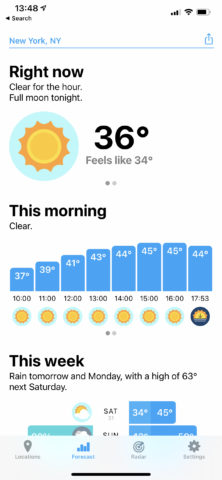
Chunky, colorful bar charts for hours and weeks ahead offer great clarity. The same is true of the app’s widget, which is the best around — albeit hampered by always displaying the most recent location viewed in-app rather than a specific user-defined place. (The app doesn’t provide a speedy way to switch locations either, which is a pity — doing so is a two-tap process.)
For a buck a month, you get useful upgrades, the most important being alternate data sources. Paying also unlocks a radar, best described as workmanlike. You’ll get the information you need, but the design lacks the coherence and impact found elsewhere. In terms of bang per buck, though, Hello Weather is the best of the apps on test, especially if you mostly care about tracking conditions for a single location.
Carrot Weather
$5/£5 + IAP • v4.16.4 • 166MB • By Grailr LLC
The oddball in the pack, Carrot Weather is helmed by a homicidal AI dedicated to eradicating humanity — but that in the meantime moonlights as a snarky meteorologist that provides commentary alongside forecasts. (Note: Carrot’s personality and politics can be adjusted if you’re offended by the app’s outbursts.)
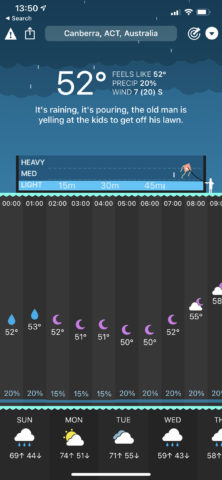
The interface itself is more illustrative than its rivals but nonetheless has hourly forecasts that resemble Weather Line’s at-a-glance conditions and temperatures. Weekly outlooks are housed in a simple horizontal ticker, although tapping a day jumps to its hourly forecast if one is available.
Customization-wise, Carrot’s a winner, with plentiful widgets, options, and sources. Its map isn’t fluid, but has multiple layers and Dark Sky-like arrows for predicting where precipitation will head. Some features sit behind IAP — see the website’s FAQ page for details — but the most important are in the lowest tiers, and Carrot’s quality and flexibility ensure value for money.
